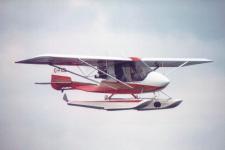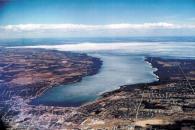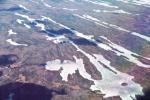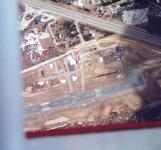|
"Toronto Terminal, Xray Sierra Lima, so long." It's April twenty-third and I'm over Alliston, just north of Toronto, making sure the Challenger's transponder and encoder are operational for next week's trip into Toronto International Airport. XSL will be on display at the Aviation & Aircraft Show and it would be a shame to be locked out because of an equipment problem. Last Monday I put the Puddlejumper amphibious floats back on XSL. That was an act of supreme optimism. The lakes are still frozen over and the tiny percentage of water which is liquid is intimidatingly cold, a fraction of a degree above freezing. However one day very soon, as if by magic, the ice will disappear and we'll be splashing around once again. The thought of this brings a smile to my face, replacing the one that was already there in appreciation of being aloft on such a fine day. I switch the radio to monitor 121.5 enroute and bank left, to the northeast. An hour's flying from here at Muskoka Airport, Elton Townsend of Lake Central Air Services is expecting me. Unfortunately he's expecting me in only thirty minutes. Best light the afterburners! Thump! At 2,500 feet AGL the Challenger starts an uncommanded roll to the right. What's happening? The variometer needle points up. This extremely sensitive vertical speed indicator, standard issue in sailplanes, is telling me we've found a thermal! The powerful late morning sun has heated the ground which has in turn brought some cool spring air to a boil. A massive bubble of now warm air, emulating a hot air balloon, has broken loose and is heading skyward. My soaring instincts take charge of the situation. Meanwhile it's back on the throttle to slow down and decrease the turn radius. The strongest lift will be at the core of the thermal - the closer we can get the better. The vario's needle is waving between 500 and 700 feet per minute up. Now the engine's set to an rpm appropriate for taxiing up a slight incline and we're doing about forty miles per hour. The turn gets even tighter. The vario gets even more interesting, sometimes indicating 1,000 fpm up! Round and round we go, rising with the rising air. As the warm air ascends the surrounding air is ever cooler and the pace picks up as the temperature differential increases. Passing through 6,000 feet the vario hits the peg at 1,200 fpm up and stays there. With the engine at a fast idle this amphibious floatplane is going up faster than it could at full throttle in still air! Overhead, wisps of white are starting to appear. A few short minutes ago the sky was an uninterrupted blue. Now all around us little cumuli are blossoming out of nowhere, as if some unseen hand has thrown a start switch. In Southern Ontario thermals are usually capped with cumulus at around 5,000 feet. Today the air is relatively dry so the condensation into cloud is taking place well above that altitude. At 7,500 feet we're at cloud base. A world class panorama presents
itself. Lake Muskoka! Oops, I forgot! Elton awaits! Oh well, he probably wouldn't believe his eyes if I showed up on time. I spool up the engine and head on course, motoring along in a shallow dive, trading altitude for speed. Our track zigs and zags from cumulus to cumulus. Each cloud marks a free elevator ride back up to cloud base. Entering the lift, a pull on the stick yields a zoom climb to take advantage of the rising air. If it's been a while since the last thermal, a few circles gives us more time to be lofted. Emerging from the far side of the lift a push on the stick accelerates us back to our diving cruise. Someone flying along straight and level would see these thermals as turbulence. Little do they know that what's a bumpy afternoon to them is a soaring pilot's dream!
There is no sound quite like the silence of flying a motorized aircraft when the motor is not running. Not long ago I was demonstrating an engine-off landing to a doctor from Newfoundland and he remarked that XSL was quieter than a glider. I hadn't thought of that before but he was right. The Challenger is actually quieter than many gliders I've flown. From this height with the engine off we can meander over 10 miles before setting up for landing, all at a cost of zero gallons per mile. I head northeast and circle the lake where I did my first water takeoffs and landings less than a year ago. What a voyage of discovery it has been! Between amphibious floats and skis I've been totally spoiled by being able to land just about any place I fancy. Back in the general vicinity of the airport, descending through 2,000 AGL, I let Muskoka Radio know we're going to join downwind for runway 36. Thump! Another thermal! There must be an epidemic! I've not tried to soar XSL on amphibs with the engine off. Why bother? Surely that would be impossible with two 14 foot objects hanging from the fuselage! Crank it over and core the thermal! This is another good one! Spring thermals are often the best of the year because the sun is relatively strong while the air is relatively cool. As well, leaves and crops don't shade as much of the ground, providing more heating surfaces to kick off thermals. This is especially true in the Muskoka region where there's a lot of rock exposed. I let Muskoka Radio know the plan has changed as we climb out of the control zone. The thermal is a bit disorganized at this lower altitude. It waxes and wanes, occasionally seeming to shift sideways to play hide and seek. The bank angle alternates between shallow and steep as we chase the rising air. Here's a really strong surge! Roll way over, past sixty degrees, to pirouette in the upward blast! The surge lessens but I keep the bank steep. At our low speed we're turning in no space at all, staying right in the juicy core. It's de rigueur to get every possible ounce of benefit from a thermal. To do so turns must be perfectly coordinated so the fuselage is aligned with the airflow and drag is minimized. In addition to the variometer XSL has another piece of sailplane instrumentation - a yaw string. This piece of wool taped to the windscreen is much more sensitive than the ball of an inclinometer and is positioned where it can be seen while looking out of the cockpit. This HUD, Heads Up Display, is quite easy to read: if the yaw string is blowing straight back there's no slip or skid. Not only that but it even works when the engine's running since the Challenger is a pusher and the prop blast doesn't thrash the wool into a frenzy. As our altitude increases the thermal becomes broader, the lift smoother and stronger. Circling in virtually total silence the effort becomes minimal. The vario goes to 700 fpm up. The engine is off. I look out at the floats. Better not pinch myself - wouldn't want to leave a nasty bruise! Seeing is believing!
We've a lot of altitude to shed - some wingovers will do the trick nicely! Nose down to 90 mph then pull gently back on the stick to start the nose coming up. Feed in some aileron to start rolling. Keep zooming up, pitching and rolling simultaneously, until we're perpendicular to our original heading, wings straight up and down in a ninety degree bank, airspeed just about gone. Then swoop down until we're level, going in the opposite direction. Link a few to form Lazy Eights! How about some super steep turns to spiral us down in a hurry! Reentering the control zone from above I level off and head for the opposite side of the runway. Thump! Crank it in! No wait, I really am late. Better pass on this one or Elton will have a conniption fit! There's no traffic so I don't bother to restart the engine. "Muskoka Radio, Fox X-ray Sierra Lima downwind for three six." "X-ray Sierra Lima report down and clear." There is something very satisfying to landing an airplane with the engine off. I play the turns to base and final to position us for a precision touch down on the runway. In a sailplane the ideal approach is flown with the spoilers half deployed. XSL doesn't have spoilers but sideslips can deliver glide path control every bit as effective. I fly down final in a medium side slip, increasing or decreasing the slip to adjust for being high or low, compensating for the vagaries of the wind. Here comes the pavement: round off, flare, let the speed bleed off, touch down gently. I restart the engine while rolling out and taxi to Lake Central. Elton, who has now been waiting quite some time, says he's been watching me circle overhead for the last half hour. "You should be playing on the way home, not on the way here!" he chides. Later in the afternoon when it's time to leave we take off from runway 36 and make a left turn out. Thump! Hmm! No more appointments! Crank it in, throttle back, core the thermal! The vario pegs. It's deja vu all over again! At 8,000 feet I aim XSL towards Barrie and head for home.
To learn and see more order our comprehensive information package and video! |




